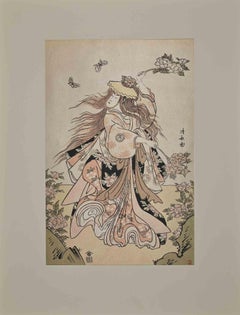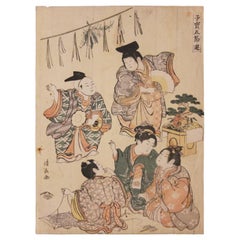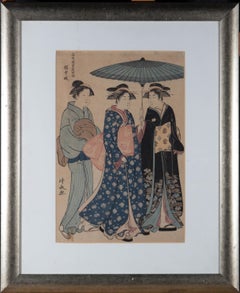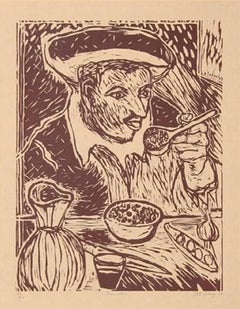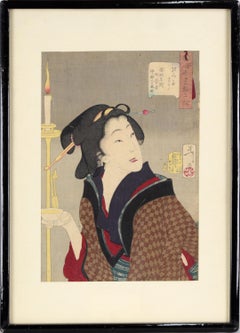Torii Kiyonaga Art
to
2
2
4
4
Overall Height
to
Overall Width
to
1
4
4
2
1
1
1
1
1
1
2
1
1
2
4
6,996
3,348
2,513
1,213
4
Artist: Torii Kiyonaga
Actor Segawa Kikunojô III - Woodcut after Torii Kiyonaga - Mid-20th Century
By Torii Kiyonaga
Located in Roma, IT
Actor Segawa Kikunojô III Performing the Lion Dance is a woodcut print realized in the early 20th Century after Torii Kiyonaga's Woodcut.
Good conditions....
Category
Early 20th Century Modern Torii Kiyonaga Art
Materials
Woodcut
Beauties under a Maple Tree Japanese Woodblock Print
By Torii Kiyonaga
Located in Houston, TX
Three Beauties under a maple tree from the series "A Contest of Fashionable Beauties of the Gay Quarters". The woodblock print is printed on rice paper....
Category
1780s Edo Torii Kiyonaga Art
Materials
Woodcut
New Year From the Series Precious Children's Games of the Five Festivals
By Torii Kiyonaga
Located in Houston, TX
Torii Kiyonaga woodblock print from the series "Prescious Children's Games of the Five Festivals." It shows five children playing with a ball and kites flying in the background. This...
Category
Early 1800s Edo Torii Kiyonaga Art
Materials
Woodcut
Torii Kiyonaga (1752–1815) - c. 1788 Japanese Woodblock, Geisha Strolling
By Torii Kiyonaga
Located in Corsham, GB
A wonderfully intricate woodblock by the 18th Century Japanese artist. Torii Kiyonaga. The scene shows two geisha strolling together around Tanaka Castle (as stated in the inscriptio...
Category
18th Century Torii Kiyonaga Art
Materials
Woodcut
Related Items
The Bean Eater
By Italo Scanga
Located in New York, NY
Italo Scanga was born in the Calabria region of Italy, and at 14 immigrated to the United States with his family after World War II. Living in Detroit, he worked on the General Motor...
Category
1980s Contemporary Torii Kiyonaga Art
Materials
Woodcut
"Thirsty: the appearance of a town geisha in the Ansei era" - Woodblock on Paper
By Tsukioka Yoshitoshi
Located in Soquel, CA
"Thirsty: the appearance of a town geisha in the Ansei era" - Woodblock on Paper
From the series "Thirty-two Aspects of Customs and Manners" (Fuzoku sanjuniso)
Lively woodblock of a...
Category
1880s Edo Torii Kiyonaga Art
Materials
Paper, Ink, Woodcut
'Madman's Drum (Plate 41)' — 1930s Graphic Modernism
By Lynd Ward
Located in Myrtle Beach, SC
Lynd Ward, 'Madman's Drum, Plate 41', wood engraving, 1930, edition small. Signed in pencil. A fine, black impression, on off-white tissue-thin Japan paper; the full sheet with margins (1 5/8 to 2 1/2 inches); a small paper blemish in the upper right margin, away from the image, otherwise in excellent condition. Scarce. Matted to museum standards, unframed.
Image size 5 1/2 x 3 3/4 inches (140 x 95 mm); sheet size 9 5/8 x 7 1/8 inches (244 x 181 mm).
From Lynd Ward’s book of illustrations without words, 'Madman’s Drum', Jonathan Cape and Harrison Smith, New York, 1930. Illustrated in 'Storyteller Without Words: The Wood Engravings of Lynd Ward', Harry Abrams, New York, 1974.
Reproduced in 'Storyteller Without Words, the Wood Engravings of Lynd Ward', Harry N. Abrams, New York, 1974.
ABOUT THE ARTIST
Lynd Ward is acknowledged as one of America’s foremost wood engravers and book illustrators of the first half of the twentieth century. His innovative use of narrative printmaking as a stand-alone storytelling vehicle was uniquely successful in reaching a broad audience. The powerful psychological intensity of his work, celebrated for its dynamic design, technical precision, and compelling dramatic content, finds resonance in the literature of Poe, Melville, and Hawthorne. Like these classic American writers, Ward was concerned with the themes of man’s inner struggles and the role of the subconscious in determining his destiny. An artist of social conscience during the Great Depression and World War II, he infused his graphic images with his unique brand of social realism, deftly portraying the problems that challenged the ideals of American society.
The son of a Methodist preacher, Lynd Ward, moved from Chicago to Massachusetts at an early age. He graduated from the Teachers College of Columbia University, New York, in 1926, where he studied illustration and graphic arts. He married May Yonge McNeer in 1936 and left for Europe for their honeymoon in Eastern Europe. After four months, they settled in Leipzig, where Ward studied at the National Academy of Graphic Arts and Bookmaking. Inspired by Belgian expressionist artist Frans Masereel's graphic novel ‘The Sun,’ and another graphic novel by the German artist Otto Nückel, ‘Destiny,’ he determined to create his own "wordless" novel. Upon his return to America, Ward completed his first book, ‘God's Man: A Novel in Woodcuts,’ published in 1929. ‘Gods’ Man’ was a great success for its author and publisher and was reprinted four times in 1930, including a British edition. This book and several which followed it, ‘Madman’s Drum,’ 1930, ‘Wild Pilgrimage...
Category
1930s American Modern Torii Kiyonaga Art
Materials
Woodcut
A Mother Takes her Son for A Walk during the Russo-Japanese War.
By Toyohara Chikanobu
Located in Storrs, CT
c. 1883. Kakemono: 28 3/8 x 9 7/16. Repairs and staining; fine color. An extremely scarce historical image. Signed Chikanobu. Housed in a 36 x 15 1/2-inch archival mat, ready for your choice of frame.
The Russo-Japanese War...
Category
Late 19th Century Edo Torii Kiyonaga Art
Materials
Color, Woodcut
H 28.13 in W 9.44 in D 0.5 in
'Simplicius' Farewell to the World' — Graphic Modernism
By Fritz Eichenberg
Located in Myrtle Beach, SC
Fritz Eichenberg, 'Simplicius’ Farewell To The World' from the suite 'The Adventurous Simplicissimus', wood engraving, 1977, artist's proof apart from the edition of 50. Signed in pencil. Signed in the block, lower right. A fine, richly-inked impression, on cream wove paper, with full margins (1 1/2 to 2 inches), in excellent condition. Image size 14 x 12 inches (356 x 305 mm); sheet size 17 1/2 x 15 inches (445 x 381 mm). Archivally sleeved, unmatted.
ABOUT THIS WORK
'Simplicius Simplicissimus' (German: Der abenteuerliche Simplicissimus Teutsch) is a picaresque novel of the lower Baroque style, written in five books by Hans Jakob Christoffel von Grimmelshausen published in 1668, with the sequel Continuatio appearing in 1669.
The novel is told from the perspective of its protagonist Simplicius, a rogue or picaro typical of the picaresque novel, as he traverses the tumultuous world of the Holy Roman Empire during the Thirty Years' War. Raised by a peasant family, he is separated from his home by foraging dragoons. He is adopted by a hermit living in the forest, who teaches him to read and introduces him to religion. The hermit also gives Simplicius his name because he is so simple that he does not know his own name. After the death of the hermit, Simplicius must fend for himself. He is conscripted at a young age into service and, from there, embarks on years of foraging, military triumph, wealth, prostitution, disease, bourgeois domestic life, and travels to Russia, France, and an alternate world inhabited by mermen. The novel ends with Simplicius turning to a life of hermitage, denouncing the world as corrupt.
ABOUT THE ARTIST
Fritz Eichenberg (1901–1990) was a German-American illustrator and arts educator who worked primarily in wood engraving. His best-known works were concerned with religion, social justice, and nonviolence.
Eichenberg was born to a Jewish family in Cologne, Germany, where the destruction of World War I helped to shape his anti-war sentiments. He worked as a printer's apprentice and studied at the Municipal School of Applied Arts in Cologne and the Academy of Graphic Arts in Leipzig, where he studied under Hugo Steiner-Prag. In 1923 he moved to Berlin to begin his career as an artist, producing illustrations for books and newspapers. In his newspaper and magazine work, Eichenberg was politically outspoken and sometimes wrote and illustrated his reporting.
In 1933, the rise of Adolf Hitler drove Eichenberg, who was a public critic of the Nazis, to emigrate with his wife and children to the United States. He settled in New York City, where he lived most of his life. He worked in the WPA Federal Arts Project and was a member of the Society of American Graphic Artists.
In his prolific career as a book illustrator, Eichenberg portrayed many forms of literature but specialized in works with elements of extreme spiritual and emotional conflict, fantasy, or social satire. Over his long career, Eichenberg was commissioned to illustrate more than 100 classics by publishers in the United States and abroad, including works by renowned authors Dostoyevsky, Tolstoy, Charlotte and Emily Brontë, Poe, Swift, and Grimmelshausen. He also wrote and illustrated books of folklore and children's stories.
Eichenberg was a long-time contributor to the progressive magazine The Nation, his illustrations appearing between 1930 and 1980. Eichenberg’s work has been featured by such esteemed publishers as The Heritage Club, Random House, Book of the Month Club, The Limited Editions Club, Kingsport Press, Aquarius Press, and Doubleday.
Raised in a non-religious family, Eichenberg had been attracted to Taoism as a child. Following his wife's unexpected death in 1937, he turned briefly to Zen Buddhist meditation, then joined the Religious Society of Friends in 1940. Though he remained a Quaker until his death, Eichenberg was also associated with Catholic charity work through his friendship with Dorothy Day...
Category
1970s American Modern Torii Kiyonaga Art
Materials
Woodcut
'The Pimp' — Graphic Modernism
By Fritz Eichenberg
Located in Myrtle Beach, SC
Fritz Eichenberg, 'The Pimp', wood engraving, 1980, artist's proof before the edition. Signed in pencil. Signed in the block, lower right. A fine, richly-inked impression, on cream wove paper, with full margins (2 3/16 to 3 1/2 inches), in excellent condition. Archivally sleeved, unmatted.
Image size 12 x 9 3/4 inches (305 x 248 mm); sheet size 18 x 14 inches (457 x 356 mm).
ABOUT THE ARTIST
Fritz Eichenberg (1901–1990) was a German-American illustrator and arts educator who worked primarily in wood engraving. His best-known works were concerned with religion, social justice, and nonviolence.
Eichenberg was born to a Jewish family in Cologne, Germany, where the destruction of World War I helped to shape his anti-war sentiments. He worked as a printer's apprentice and studied at the Municipal School of Applied Arts in Cologne and the Academy of Graphic Arts in Leipzig, where he studied under Hugo Steiner-Prag. In 1923 he moved to Berlin to begin his career as an artist, producing illustrations for books and newspapers. In his newspaper and magazine work, Eichenberg was politically outspoken and sometimes wrote and illustrated his reporting.
In 1933, the rise of Adolf Hitler drove Eichenberg, who was a public critic of the Nazis, to emigrate with his wife and children to the United States. He settled in New York City, where he lived most of his life. He worked in the WPA Federal Arts Project and was a member of the Society of American Graphic Artists.
In his prolific career as a book illustrator, Eichenberg portrayed many forms of literature but specialized in works with elements of extreme spiritual and emotional conflict, fantasy, or social satire. Over his long career, Eichenberg was commissioned to illustrate more than 100 classics by publishers in the United States and abroad, including works by renowned authors Dostoyevsky, Tolstoy, Charlotte and Emily Brontë, Poe, Swift, and Grimmelshausen. He also wrote and illustrated books of folklore and children's stories.
Eichenberg was a long-time contributor to the progressive magazine The Nation, his illustrations appearing between 1930 and 1980. Eichenberg’s work has been featured by such esteemed publishers as The Heritage Club, Random House, Book of the Month Club, The Limited Editions Club, Kingsport Press, Aquarius Press, and Doubleday.
Raised in a non-religious family, Eichenberg had been attracted to Taoism as a child. Following his wife's unexpected death in 1937, he turned briefly to Zen Buddhist meditation, then joined the Religious Society of Friends in 1940. Though he remained a Quaker until his death, Eichenberg was also associated with Catholic charity work through his friendship with Dorothy Day...
Category
1980s American Modern Torii Kiyonaga Art
Materials
Woodcut
Viewing snow at Mount Matchi. (Matsuchiyama no yukimi.)
By Torii Kiyonaga
Located in Storrs, CT
Torii Kiyonaga. (after). Twentieth-century woodcut printed on silk, based on the original Kiyonaga 1784 woodblock. 13 1/2 x 6 1/2 (image and sheet). Scattered foxing. Signed "Torii K...
Category
Early 19th Century Edo Torii Kiyonaga Art
Materials
Color, Woodcut
The Samurai Genta Kajiwara - Japanese Woodblock Diptych in Ink on Paper
By Utagawa Yoshitora
Located in Soquel, CA
The Samurai Genta Kajiwara - Japanese Woodblock Diptych in Ink on Paper
Boldly colored woodblock by Utagawa Yoshitora (Japanese, active c.1840-1880)...
Category
1860s Edo Torii Kiyonaga Art
Materials
Paper, Ink, Woodcut
H 21 in W 32 in D 0.25 in
Angor Vhat.
By Elyse Ashe Lord
Located in Storrs, CT
Angor Vhat. 1930. Woodcut and drypoint printed in colors. 11 x 13 (sheet 15 7/8 x 16 7/8). Edition 75, # 22. A bright, colorful impression printed on Japanese mulberry paper, with an irregular bottom margin. Signed and numbered in pencil. Housed in a 18 3/8 4 x 19 1/2-inch archival mat, suitable for framing.
----------------------------------------------------------------------------------------------------
Elyse Ashe Lord was a British artist and illustrator who worked in watercolors and drypoint etching. She studied at the Heatherley School of Art in Chelsea. The first public exhibition of her work was in 1919. Her drawings were exhibited at the Brook Street Gallery in 1921.[ In 1922 she became a member of the Royal Institute of Painters in Water Colours. Various large exhibitions of her works were held during her lifetime.
Her images typically draw on the Art Deco movement and ideas of Oriental culture, despite the fact that she never visited the Far East. She was a popular artist, even during a time period when the art market, and decorative arts particularly, was suffering from the economic crisis of the 1930s. She lived in Bexley in Kent.
----------------------------------------------------------------------------------------------
Angkor Wat, in its beauty and state of preservation, is unrivaled. Its mightiness and magnificence bespeak a pomp and a luxury surpassing that of a Pharaoh or a Shah Jahan, an impressiveness greater than that of the Pyramids, an artistic distinctiveness as fine as that of the Taj Mahal. Angkor Wat is located about six kilometers (four miles) north of Siem Reap, south of Angkor Thom...
Category
1920s Modern Torii Kiyonaga Art
Materials
Color, Drypoint, Woodcut
Annunciation - Woodcut after Albrecht Durer - Early 20th Century
By Albrecht Dürer
Located in Roma, IT
Annunciation is a woodcut print realized after Albrecht Durer in the early 20th century.
Good conditions with slight foxing.
The artwork is created through deft strokes by mastery.
Category
Early 20th Century Modern Torii Kiyonaga Art
Materials
Woodcut
H 13.39 in W 9.45 in D 0.04 in
The Encounter - Woodcut by Ferdinando Codognotto - 2023
Located in Roma, IT
The encounter is an artwork realized by Ferdinando Codognotto in 2023.
Woodcut based on stencil of 1971.
50 x 36 cm.
Hand signed in the lower right margin.
Good condition.
Category
2010s Modern Torii Kiyonaga Art
Materials
Woodcut, Paper
H 19.69 in W 14.18 in D 0.08 in
'City Lights' — Vintage Wood Engraving, New York City, 1934
By Fritz Eichenberg
Located in Myrtle Beach, SC
Fritz Eichenberg, 'City LIghts', wood engraving, 1934, edition 200. Signed, titled 'Lights', and annotated 'No 2/200 for Howard M. Chapin' in pencil. Initialed in the block, lower right. A fine, richly-inked black impression, on cream wove paper, with full margins (1 1/4 to 1 7/8 inches); a small loss (5/8 inch) in the top right sheet corner, well away from the image, otherwise in excellent condition. Printed by master printer Ernest Roth...
Category
1930s American Modern Torii Kiyonaga Art
Materials
Woodcut
Previously Available Items
Torii Kiyonaga (1752–1815) - c. 1788 Japanese Woodblock, Geisha Strolling
By Torii Kiyonaga
Located in Corsham, GB
A wonderfully intricate woodblock by the 18th Century Japanese artist. Torii Kiyonaga. The scene shows two geisha strolling together around Tanaka Castle (as stated in the inscriptio...
Category
18th Century Torii Kiyonaga Art
Materials
Woodcut
Torii Kiyonaga art for sale on 1stDibs.
Find a wide variety of authentic Torii Kiyonaga art available for sale on 1stDibs. You can also browse by medium to find art by Torii Kiyonaga in woodcut print and more. Much of the original work by this artist or collective was created during the 18th century and is mostly associated with the modern style. Not every interior allows for large Torii Kiyonaga art, so small editions measuring 9 inches across are available. Customers who are interested in this artist might also find the work of Kunichika Toyohara, Utagawa Yoshitora, and Toyohara Kunichika. Torii Kiyonaga art prices can differ depending upon medium, time period and other attributes. On 1stDibs, the price for these items starts at $112 and tops out at $1,615, while the average work can sell for $900.
